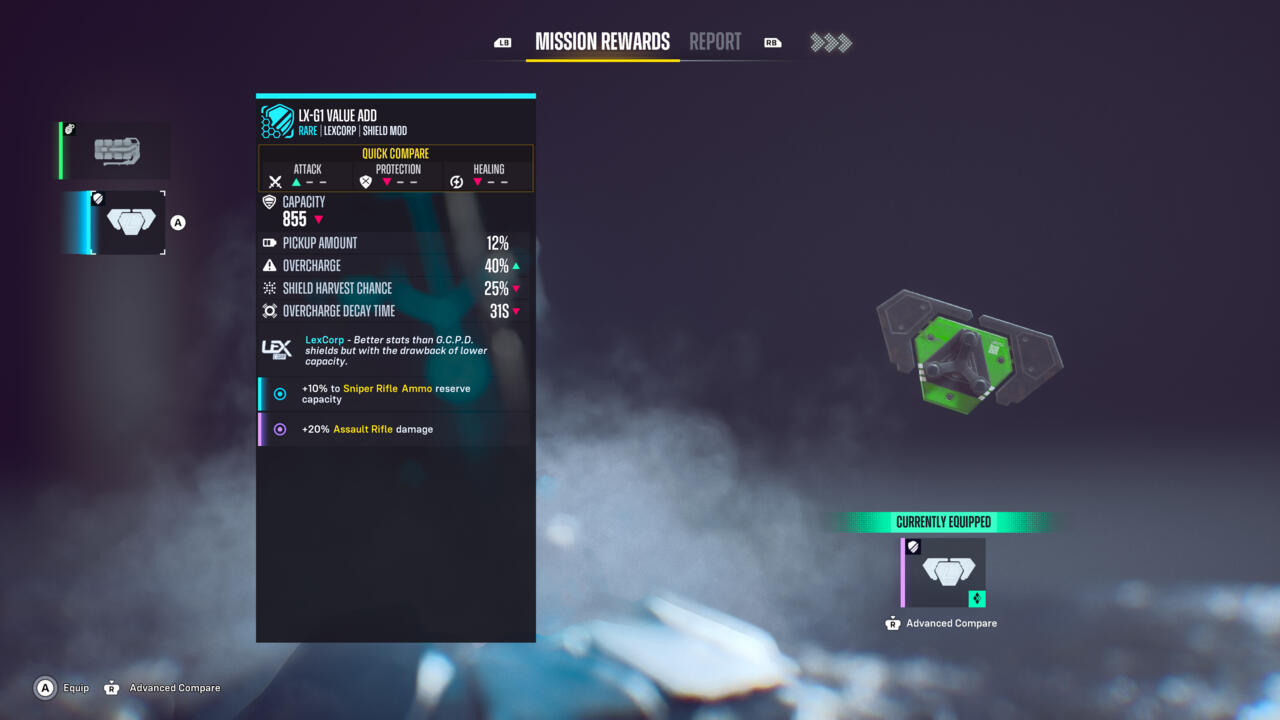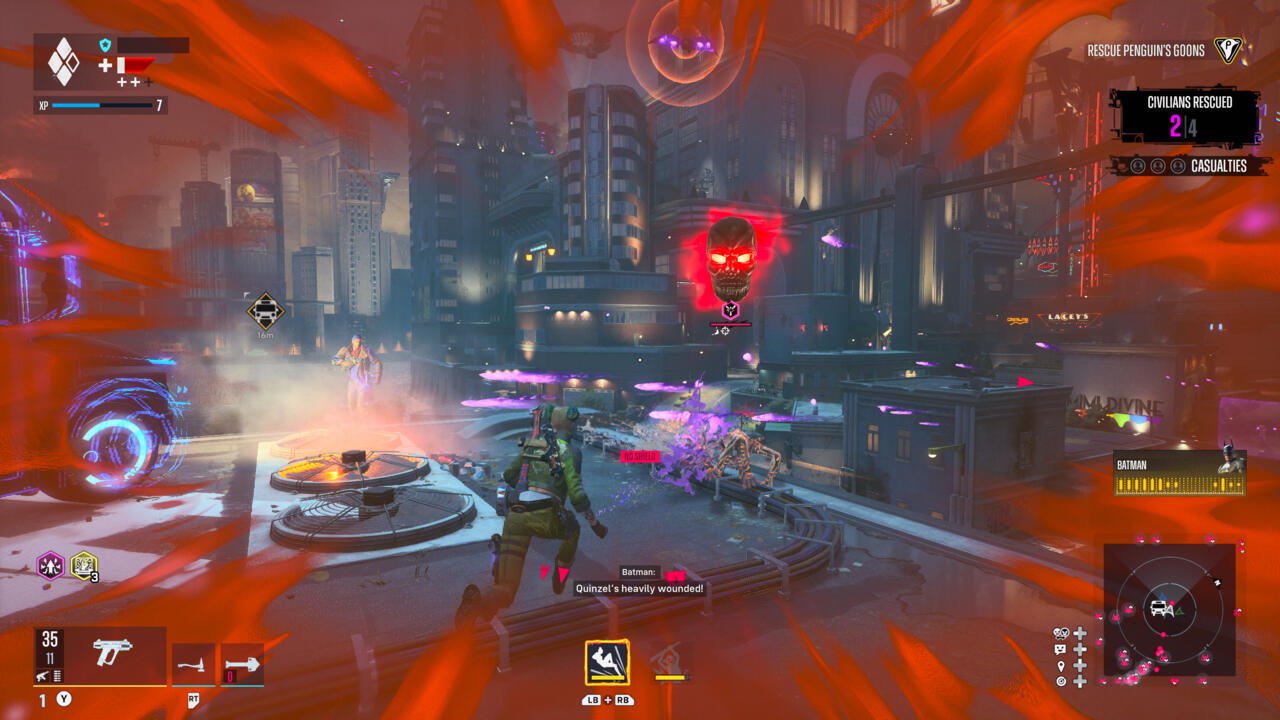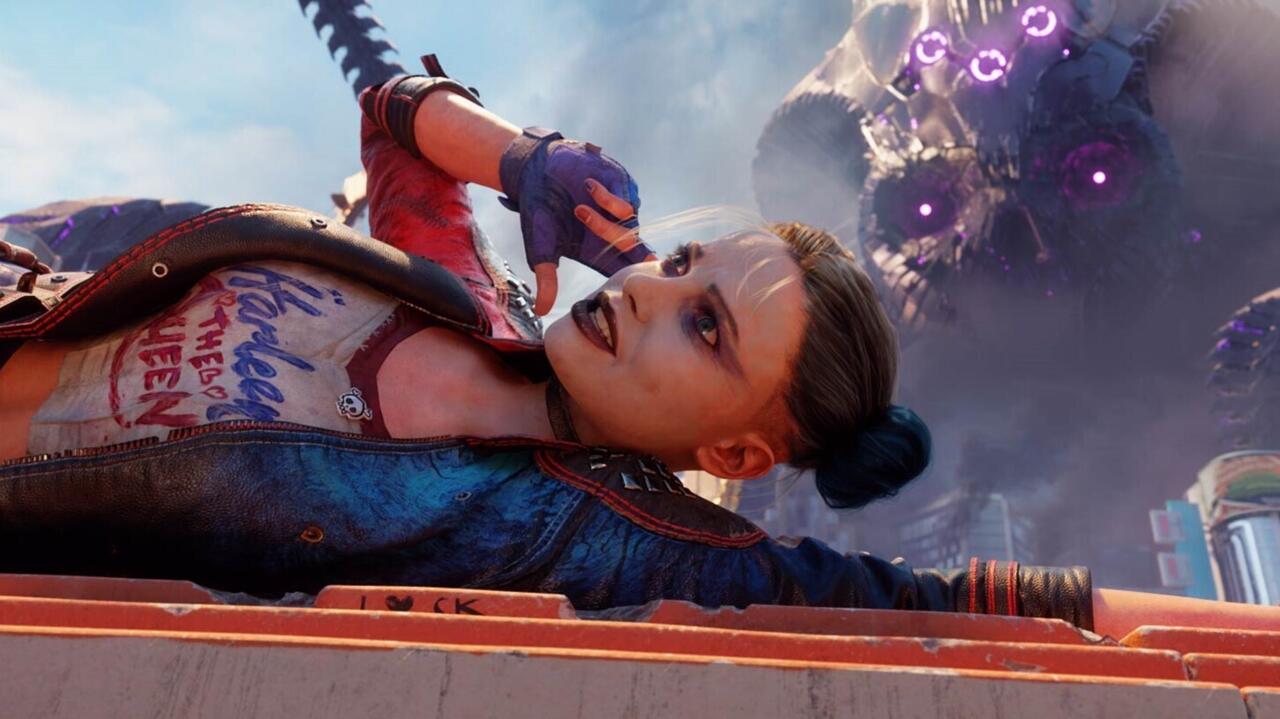The tightrope to walk when writing a review is assessing a game for what it is, not what you wished it would be. Though some wished Rocksteady would make a game more like its Batman Arkham series, it’s not fair to critique Suicide Squad: Kill The Justice League for being something other than that. Instead, one must examine it for what it is: a game-as-a-service looter shooter applied to an all-star roster of DC Comics heroes and villains. You zip about a city, shoot aliens, get gear, and repeat. And, as it turns out, that game isn’t very good.
In Suicide Squad, teams of one to four players step into the boots of DC Comics’ wise-cracking villains Harley Quinn, Deadshot, King Shark, and Captain Boomerang. Designed in a similar vein as Crystal Dynamics’ Avengers and WB Montreal’s Gotham Knights, Suicide Squad is an open-world game littered with proper nouns like Afflictions, Boosts, and Shield Harvesting, buried in colorful resources, and intensely focused on having players chase better and better loot such as guns, shields, and melee weapons as it (and the all-important endgame) goes on. The intent is to keep players invested for months to come, and the game isn’t shy about that.
Suicide Squad’s premise–in which the titular foursome must battle the typical good guys as they’ve been taken over by Brainiac–would’ve made a hell of a comic book, and though it should work as a game just as seamlessly given how well superhero fare can translate to games, it sometimes struggles to do so given how it bizarrely moves past would-be major events with the spectacle of an office party.
The game gives each anti-hero space to quip and play off one another in a way that matches the tone of other Suicide Squad stories. It’s aggressively violent, irreverent, and stupid-funny, but that’s exactly as it should be with this batch of mouthy, expendable villains meant to disarm Brainiac and the drones he’s made out of the world’s greatest heroes. The cast does an excellent job bringing the main characters to life, especially AEW’s Samoa Joe, who shines as King Shark and may have cemented his acting career as a result.
Though I enjoy the characters themselves, there are some spoiler-filled moments I won’t detail that end up feeling off, considering the enormity of the titular task at hand. I sometimes found myself wanting more time with the Justice League, who are iconic heroes-turned-villains, but the game often hurried me through those story beats in a way that felt unceremonious. Ultimately this tendency served as a frequent reminder that, in a genre like this, the story often struggles to rise above mere set dressing. There are shades of Rocksteady’s brilliance still intact, but killing the Justice League should feel like an epic saga, and it never manages to do that.
I would’ve expected the Justice League to be inherently compelling villains given how the conceit flips the way they’re usually portrayed on its head, and yet they’re often either one-dimensional, such as Superman or Batman, or cliche like The Flash and Green Lantern. The idea of Superman finally losing control and turning on everyone is a fascinating opportunity to explore the character through a new lens but, for whatever reason, Rocksteady didn’t see what was there.
Batman’s handling, meanwhile, feels like a particularly upsetting betrayal given that Rocksteady spent so much time and effort building up their take on him in the Arkham games. And yet, this version trades that and the decades of characterization that exist for a simple-minded cartoon villain who is given a very unfitting conclusion to his story.
For Green Lantern, the game leans into the space cop shtick, which is the most superficial take on a character that is driven by the power of his own will. I found it strangely easy to forget the supposed stakes of the Suicide Squad’s action, and the way the heroes-turned-villains were portrayed did very little to remind me of it.
Wonder Woman’s role brings a unique and more interesting wrinkle to the story, but the way she exits the story, like all others in the game, feels brushed aside. You as the player, and Rocksteady as the developer, alter the canon of its DC universe in some earth-shattering ways, but these moments come and go like you’ve merely checked off some items on a to-do list.
In an open-world Metropolis threatened by countless alien goons, and equipped with some gear they’ve stolen from the Hall of Justice, the Suicide Squad brings a bit of the Justice League’s skill sets to the game, with Boomerang utilizing Flash’s Speed Force to blink across gaps and Harley relying on Batman’s drone, from which she grapples and swings like a new Robin in training.
Combat and traversal are meant to work in tandem to create a free-flowing minute-to-minute experience that feels good in your hands and looks stylish and powerful on screen. But it never quite gets there due to several issues, such as limitations on those traversal items and, to a more harmful extent, enemies with such specific weaknesses that combat feels like a battle between player and in-game systems. For example, certain enemies may be dispatched using only Afflictions (status effects), counters, critical hits, grenades, boosted attacks, or other strategies. This routinely feels chaotic and frustrating, as some missions may throw all types at you at once and you may be without solutions some of the time.
Playing in co-op reduces this struggle as each player can bring more of a particular play style to the fray than your AI allies may. But through this gameplay design, Suicide Squad strangely rejects playing like a traditional shooter, and the depth of this alternative design doesn’t outweigh how it sometimes hamstrings progress or the game’s intended power fantasy.
Enemies who must be countered demand a quick-time-event-like response, but countering them, especially from a longer range, proved unreliable, leaving me whiffing on a shot I lined up well and then taking damage. The same can be said of shield harvesting, a process in which you hurt enemies in such a way that you can heal by defeating them. One way to prime them for shield-harvesting is shooting them in the legs, but I saw many times where this simply didn’t work, causing me to unload a lot of ammo from Harley’s SMG to no benefit.

Guns of different classes as well as qualities are often easy to tell apart. While a weapon’s inherited traits can be considered for certain builds, or even altered to better suit your play style, the foundational classes of things like pistols, SMGs, snipers, and more each feel like you’ll easily find a personal favorite, or group of favorites, and focus on altering or crafting new guns in those classes. I played most of the game as Harley and therefore got used to her expertise with SMGs, but I also loved switching to Deadshot as sniping felt reliable and punchy.
Each character has a few classes they can equip but no one can equip every class, so a combination of the character’s traversal tools, available weapon classes, and your group dynamic may all lend themselves to you finding a main character for yourself, and the game lets you seamlessly swap between any of the characters at any time out of combat so you can, if you so choose, get to grips with the game’s full range of loot.
Because traversal items operate on strict cooldowns, the game never lets you consistently move in the coolest ways on offer. Instead, it wants you to routinely touch ground (or more likely roofs) to reset your cooldowns, thereby resulting in a movement style that, no matter which character you main, demands some wall-climbing, jumping, flying, and sliding. It sounds cool but in practice feels restrictive. I understand the reason players aren’t allowed to endlessly zip around as Harley–she’s not Spider-Man after all–but in a world where Spider-Man already set the bar for traversal systems in superhero games, it’s frustrating to take a step backward.
Suicide Squad doesn’t want to be Spider-Man, but it seems to want to be Sunset Overdrive, and it lands far from that goal, too. Those foundational movement tools, flawed as they are, are also not able to be upgraded in any way. This led to moments where, for example, rather than look cool as I took out a group of enemies, I might plummet well below the skyscraper rooftops needing to scale back to the top to continue fighting simply because Boomerang ran out of Speed Force charges. Because I couldn’t improve those gameplay features with upgrades, I instead learned to accept that the fluidity I was searching for just wasn’t coming. Character growth is absent in anything beyond numbers going up on equipment, and this is deeply unsatisfying.
With only one type of side activity to take part in between the game’s actual missions, the open-world cityscape has no personality either. So not only does the game force me back onto solid ground with half-baked traversal mechanics, but that time spent with boots on the ground is nondescript. Metropolis is a tall, purple-infested city where landmarks feel almost non-existent. In 30+ hours of play, I can’t recall one interesting sight I saw in the city. The whole world devolves into stuff to jump off of so I can fly again.
The game’s worst offense is the amount of visual noise happening at all times. I have never seen such a mess of meters, prompts, effects, and data sprawled across my screen in one game. It feels like it wasn’t optimized, as some aspects, such as ability cooldowns, take up an oddly large portion of the screen and could’ve been rectified with some fine-tuning.
There are options to turn off several pieces of the HUD, but even with tweaks, it’s impossible to strike a good balance of what you need and what you want to see. With an unholy mess of stuff on the screen at nearly all times, Suicide Squad looks like what people who don’t play video games think video games look like. I’m astounded that it launched in this manner, frankly. All of this visual noise doesn’t just look ugly, it actively hurts the combat. With so much being thrown on the screen at any time, important prompts like shield-harvests or counters are sometimes lost in the chaos.

Server issues have persisted in my week with the game, too, including some crashes that have come after I beat a mission, demanding I replay it to mark the progress I’d just lost, or times when I’d go to log in to the game and it wasn’t online, and was therefore unplayable (though an offline mode is coming sometime later).
It also defies story logic to suggest, as Rocksteady does, that this game takes place in the Arkhamverse. The main missions, most of which would feel like any other game’s side missions, involve repeating multiplayer-centric objectives such as pushing the payload a la Overwatch or something like Call of Duty’s Domination, where you fight to control different points until victory. There’s no way to cleanly reconcile this game’s obsession with pick-ups and resources and repetitive objectives with what we’ve seen from Rocksteady before. In no other way do I intend to compare this game to those ones, but since the studio insists this is a quasi-sequel, it bears mentioning that this world seems to operate on different rules than the last one, with little to no reasoning in the story to explain why this is. Of course, it’s obvious in a meta sense: The loot grind demands it.
Many hours into my playthrough, Harley Quinn said something I hadn’t heard her say before, and it perfectly encapsulated my experience with Suicide Squad. Dismissive to the quest-giver over the radio, she interrupted to say, “Kill aliens. Get to your number. Got it, pal.” It was perfect. For me, it was the game’s way of removing its mask and revealing its true identity. While the characters are fun, the stakes of the story are under-served, and much of what Rocksteady was previously known for seems to be shuffled to the back of the stage in favor of repetitive missions where the reward isn’t the gameplay itself, but the new items you unlock for having endured it.
But like any looter shooter, the game doesn’t feel like it truly begins until the all-important endgame. For all of the aforementioned grievances I have with Suicide Squad, I must say the endgame loot chase is strong and well-developed. It doesn’t defy or reimagine the long-tailed systems we’ve seen previously–in fact, several major and minor components feel like The Division reskinned in superhero garb–but it at least applies those principles in a way that feels ingrained in the game.
In past games like it, the endgame felt undercooked (Avengers) or virtually tacked on (Gotham Knights). Here, the game feels like it’s pushing players toward that endgame from the very beginning. And while that may be a disservice to the story, it’s undeniably the point of this game, so it’s nailing what it’s meant to do best.
The early-game skill tree casually suggests different build styles for you to focus on, and though you can ignore these at your own discretion, they help greatly in creating an endgame character who can become a benefit to their squad. You can have a build focused on buffs for certain combo milestones, or focus entirely on setting up your allies with unique guns that deal damage in specific ways, or perhaps deal no damage at all but throw enemies into the air for your team to detonate in one devastating Suicide Strike.
Whereas in the early-game portion I would sometimes find guns and other items that didn’t exactly fit my build despite being more powerful, the endgame loot seems to be a clear and enticing step up. My time-to-kill dropped noticeably once I equipped my first Bane-inspired gun, which is only available in the endgame. This was enhanced further when I equipped several Bane items and unlocked their group bonuses, much like you’d see in Diablo or games like it. Naturally, the pull here is going to be the perpetual recycling of new and better loot over time, always making what you have now seem inferior later on and teasing players to chase the next step up, eventually playing for weeks, months, or years, if its publisher’s vision comes to fruition. From what’s in the game today, Suicide Squad seems like it will fulfill that promise well, provided a community is there to become invested.

It’s a daunting and awkward task to ask fans of Rocksteady’s past games to be invested in builds and loot over story and interesting boss battles, but if you consider there is an audience for this sort of thing, I feel Suicide Squad comes out stronger than some others in this space, especially at launch. This is a game where beating the story and hitting level 30 is only a small fraction of what players are intended to do. For the team focused on well-timed cooldowns, combining elements in explosive ways, and playing to each other’s strengths to cover up weaknesses, Suicide Squad runs deep. I can only assume its long time in development was partly spent learning from others’ mistakes and best practices.
In the nine years since Rocksteady’s last game, the superhero genre in video games has shifted dramatically, from a story-driven solo experience evocative of comic books to the multiplayer loot-obsessed open worlds of the current day. Returning to tell a new story in the superhero world meant adapting to that landscape, and Rocksteady does better than its predecessors in this endeavor. And yet, thanks to repetitive mission structure, wildly messy visual noise, server issues, frequent combat and movement hindrances, and a setting void of personality, it’s still well below the quality this studio has shown it’s capable of. I consider Suicide Squad: Kill The Justice League to be the best this melding of heroes and loot grinds has produced so far, but it’s a low bar and proof that ‘best’ doesn’t necessarily mean ‘good.’
